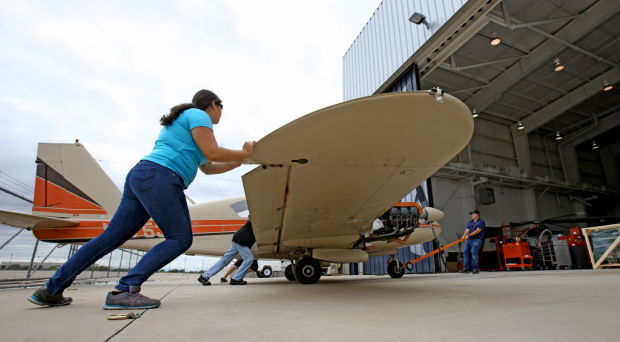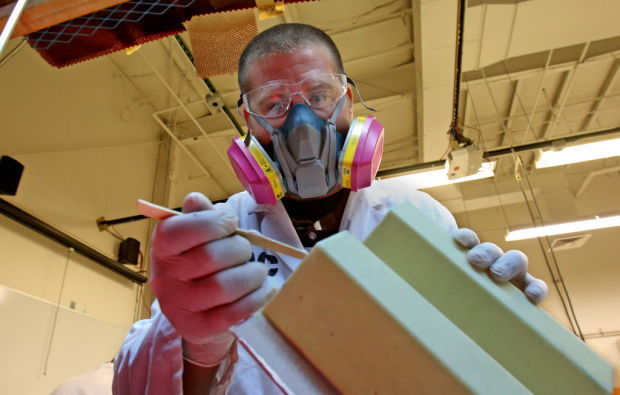Pima Community College’s highly regarded Aviation Technology Program is looking to expand its footprint at Tucson International Airport and eventually add student capacity.
The Tucson Airport Authority last week approved an amendment to Pima’s lease at TIA that increases the area leased by the college to 6.6 acres, from 4.8 acres rented under a 30-year lease signed in 2001.
The new space will allow Pima to build a warehouse for equipment and parts as well as make more room for aircraft and instruction. The original rent was prepaid in full; the new space will cost the college about $31,000 as a lump-sum prepayment.
The Pima Community College governing board must still approve the amended lease and allocate funding for the project, which the board is expected to consider sometime in the fourth quarter, said Tom Hinman, manager of Pima’s aviation-tech program.
The planned 4,500-square-foot warehouse, which would be built on vacant land on the center’s north side, would make the equipment changeovers for each five-week class cohort easier and allow space for equipment now stored outside for lack of indoor space, he said.
“We need to get some of this stuff we have outside under roof, and we need to take care of these training aids,” Hinman said. “We think that extra ramp space out there will accommodate us for quite some time.”
The warehouse project is just one of several improvements Pima plans to meet demand.
Plans also are in the works to build a large awning along the center’s south side to allow more outside work, and to extend parts of the center to build more faculty office and, eventually, classroom space, Hinman said.
The aviation program has been operating near its FAA-approved capacity of 150 students annually, and last year the department began staggering the cohorts of students to maximize the facilities while staying within enrollment limits, Hinman said. Students attend class at the center five days a week, eight hours a day.
Pima students have been hired locally by Bombardier Aerospace, which has ramped up its regional-jet maintenance center at TIA in recent years; as well as by Ascent Aviation Services, Marana Aerospace Solutions and Universal Avionics. Others have been snapped up nationally by the likes of Gulfstream Aerospace, Southwest Airlines and engine maker Pratt & Whitney.
Pima Community College Chancellor Lee Lambert has called the aviation program a “model employer-educator partnership.”
In a presentation to a legislative committee in February, Lambert said the college’s goal is to expand the program’s capacity by 25 students to meet entry-level employment needs of area businesses, and to add equipment to keep its training up to date with new technology.
Founded in 1969, Pima’s FAA-certified aviation program is one of the most extensive in the nation, offering certificate and associate-degree programs in airframe and power plant, structural maintenance including composites, and avionics to prepare students for required FAA examinations. It’s also one of a few programs that offer students the chance to work on full-size jetliners, including two Boeing 727s donated by FedEx in 2012 and 2003.
Most in Pima’s aviation-tech graduates have job offers or have accepted positions by the time they graduate, Hinman said.
Entry-level aviation mechanics start at wages of $16 to $18 an hour, he said. The median pay for aircraft mechanics was about $26 an hour or about $55,000 a year in 2012, according to federal statistics.
The cost of a two-year degree at Pima, including tuition and fees, is about $15,000 to $20,000, while FAA examinations cost about $1,100 to $1,250, Hinman said.
The Pima program provides a steady stream of qualified entry-level workers, said John Owen, director of quality for Ascent Aviation, which specializes in maintenance and overhaul of narrow-body jetliners.
“Everybody wants highly experienced, highly skilled people, but you’ve got to have a mix,” said Owen, who spoke at the Pima program’s graduation ceremony in mid-August.
“The entry level folks coming out of that (Pima) program are well-trained, they have a good background and are highly motivated.”
Employment in the various aviation technical trades is expected to grow only about 2 percent from 2012 to 2022, according to the U.S. Bureau of Labor Statistics.
However, industry economists see a far greater need.
Boeing Co.’s annual Pilot and Technician Outlook for 2014 estimates that 109,000 additional aviation technicians will be needed across North America over the next 20 years, while 584,000 will be needed worldwide.
Ascent employs about 160 people, including a few from the Pima program, but it will soon need more workers for its site just north of the Pima tech center on the airport’s west side.
The company recently began construction of a new hangar that is expected to be completed by the end of December, Owen said.
“We’ve got to put some work in there, and we’ll need more technicians, so it’s good timing,” he said.





